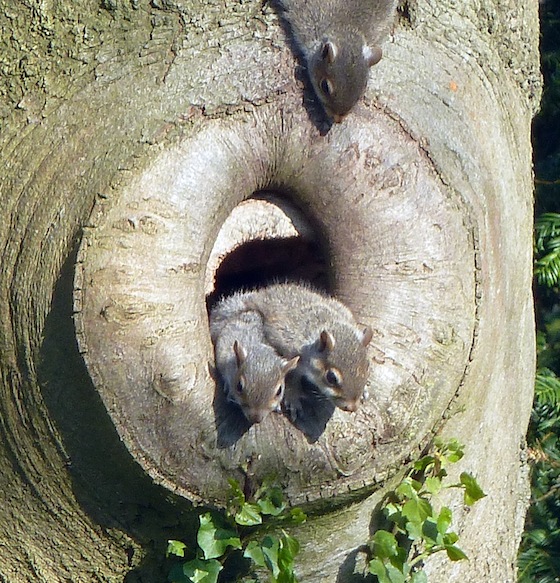- Thursday, December 04, 2025
- Stay Connected
 Abraham Lincoln
If given the truth, the people can be depended upon to meet any national crisis...
Abraham Lincoln
If given the truth, the people can be depended upon to meet any national crisis...
 Guildford news...
for Guildford people, brought to you by Guildford reporters - Guildford's own news service
Guildford news...
for Guildford people, brought to you by Guildford reporters - Guildford's own news service
Squirrels Looking For a Home
Published on: 1 May, 2012
Updated on: 1 May, 2012

"This could be a lovely home dear - but I still have that feeling that I am being watched!" Photo Don Hunt©
It is hard not to be charmed by these little chaps, photographed a few days ago on St Catherine’s Footpath, off the Portsmouth Road, by Don Hunt, who kindly sent it in for us all to enjoy. However, it is well known that grey squirrels, intentionally introduced from North America by Victorians who thought they would be novel, have ousted our native and perhaps cuter red squirrel in most parts of the UK.
The Conservation Issues Website gives a detailed answer to the question, why is it that these apparently similar species cannot live together?
John Gurnell of the Mammal Society believes that, “while there is no evidence that grey squirrels aggressively chase out red squirrels, or that grey squirrels brought a disease with them from North America that effect red squirrels, there can be no doubt that if the grey squirrel had not been introduced to Britain then the red squirrel would still be common in our parks and woodlands”.
When the ecology of each species is compared, the reasons for the dominance of the grey squirrel over the red become all too apparent. Grey squirrels can weigh as much as 600 grams, twice that of an adult red squirrel, and live for an average of 7-9 years, compared to 6-8 years for reds.
Unlike the red squirrel, which is primarily arboreal and spends only 33% of its time on the ground, the grey squirrel spends up to 80% of its time foraging on the woodland floor. This adaptation means that, in the autumn, grey squirrels can increase their body weight by as much as 20% while reds, which feed far less efficiently in broadleaved woodland, rarely manage to gain 10%.
As neither grey nor red squirrels hibernate and both are therefore active throughout the winter months periods of extreme weather, when they are forced spend several days in the drey without feeding, can have severe consequences for the red squirrel, which cannot store as much fat as the grey. This deficiency is reflected in the fact that only 80% of young red squirrels survive their first winter and mortality remains as high as 50% in adults.
In addition to all of these competitive advantages, there is another that the grey squirrel has over the red that could prove to be the most significant for the red squirrels survival. In 1984 in East Anglia, a squirrel was found to be infected with a disease that was identified as a parapoxvirus.
This disease, which is carried asymptomatically by grey squirrels, is fatal in red squirrels and, although John Gurnell is not convinced that it has been proven, many other researchers do believe that transmission of a parapox viral disease between the two species is now a major cause of the grey squirrel’s displacement of the red. They suggest that it is not that the parapox virus is a novel infection in Britain, but that the greater susceptibility of the red squirrel to the disease puts them at a huge disadvantage when trying to compete in a mixed squirrel population.














Recent Comments